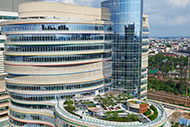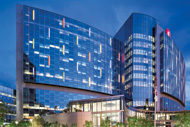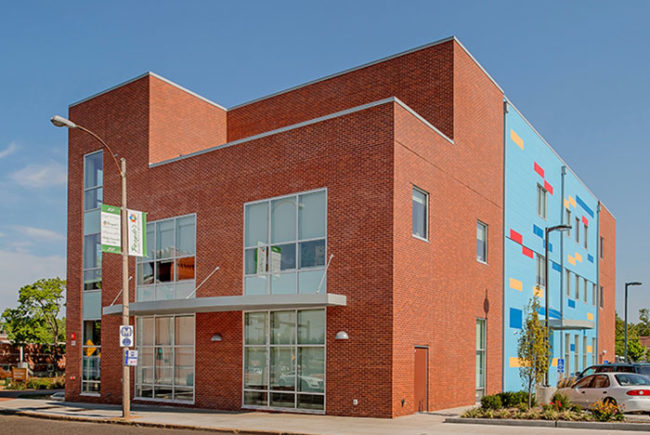
View "Pediatric facility design for all ages" Gallery
Pediatric facility design is not mere child’s play. Facilities designed for the care of young patients must deliver the same messages of permanence, confidence and technical currency that general acute care and ambulatory facilities strive to communicate, and they must do this in a noninstitutional manner that is playful but not trite. These goals are “extraordinarily difficult to achieve” and “in many ways at cross-purposes,” says Douglas Carney, AIA, ACHE, LEED AP, senior vice president for facilities, real estate, planning, design and construction for the Children’s Hospital of Philadelphia (CHOP).
“You’re doing more than just treating and healing,” in pediatric facilities, says Kristin Ledet, IIDA, senior vice president and interiors director for Houston-based architecture firm FKP. These spaces must also engage, delight and provide fun, while meeting the special needs of children and families dealing with medical issues.
Small patients, big needs
A big misconception about pediatric facility design is that smaller patients need smaller spaces, says Natalie Hagerty, AIA, EDAC, Six Sigma Green Belt, director of facilities planning, CHOP. “In fact, it means we need even greater spaces,” she says.
You may also like |
| TV systems and mobile devices improve engagement |
| Children’s hospital adopts water conservation |
| Family focus drives facility design |
| |
With patients ranging from neonates to young adults, pediatric facilities have to stock a variety of sizes of medical equipment and other items used for patient care. Bed storage, for example, must handle everything from isolettes to adult-sized beds. Support services, like the pharmacy, must accommodate a broad range of body weights and physical development. Pediatric patients have a variety of accessibility needs. In addition, pediatric facilities include space for child life services, like schoolrooms, playrooms and teen lounges. Family support spaces also are essential.
“Pediatric patients don’t come to or stay in the hospital or the clinic by themselves. Their families are an integral part of their care,” says Karen S. Freeman, AIA, ACHA, NCIDQ, director of health care planning for design firm Stanley Beaman & Sears (SBS), Atlanta. “Whatever we design should support the family unit as they move through the process together.”
In the inpatient environment, this can mean family respite or education areas on the patient unit and amenities within the patient room that support parenting other siblings; running the household from the hospital, if necessary; and continuing to work. Good sleeping accommodations, space to store personal items, a work surface and Internet access can be vital for parents. A small table for family dining or activities like coloring or playing games together can make a hospital room “feel a little more like home,” says Freeman.
Joe Kuspan, AIA, EDAC, senior vice president, designer and planner, FKP, says pediatric settings were at the vanguard of designing spaces for families to be involved in patient care. “I’ve seen adult care come around much, much closer to what we’ve been doing in pediatrics for decades now, in terms of dealing with the family,” he says.
This July, the University of Rochester (N.Y.) Medical Center opened Golisano Children’s Hospital, an eight-story, 245,000-sq. ft. facility built adjacent to the medical center’s Strong Memorial Hospital. Previously, Golisano Children’s Hospital operated as a “hospital within a hospital” in the Strong Memorial facility. Susan K. Bezek, R.N., PNP-BC, the hospital’s associate director of pediatric nursing, says the project team for the new Golisano Children’s Hospital building wanted to create a healing place for families, designed to decrease the fear and anxiety of hospitalization.
The new hospital has 52 general care patient rooms, each with dedicated family space, and a number of family amenities on the patient units. These include kitchen facilities and a lounge where people can greet visitors or sit and talk away from the patient room. The 68-bed neonatal intensive care unit (NICU) is also designed for increased privacy and family space; a lounge on the NICU floor includes a fireplace and a place for parents to work. A clubhouse for patients’ siblings is located on the first floor. A Ronald McDonald House located in the Strong Memorial Hospital facility provides guest rooms and other services for patients’ families. In addition, Ronald McDonald House has partnered with the health care organization to operate a family room on the first floor of Golisano Children’s Hospital that includes respite space, a dining area and laundry services, says Bezek.
Pediatric outpatient environments are being designed to accommodate families, too. “Even for just an exam room visit, it’s not uncommon for the family to show up with a handful of siblings,” Freeman says. Waiting areas with plenty of seating and ways to engage children who are feeling well and those who aren’t can make the experience better for everyone.
The Battle Building, a seven-story, 200,000-sq. ft. ambulatory care facility at the University of Virginia (UVA) Children’s Hospital, Charlottesville, which opened in June 2014, features full-height glass in the lobby to provide a visual connection to an adjacent park that was designed and built as part of the Battle Building project. Waiting rooms on the upper floors have views to the nearby Shenandoah Valley. A third-floor rooftop garden gives patients, families and staff a place for outdoor respite.
Benches in the exam rooms provide comfortable seating for multiple people. The exam rooms are decorated with silhouettes comprising small pictures, like animals and musical instruments, to help keep children occupied with storytelling and I-spy games. Additional interactive games and artwork are located on each floor [see sidebar, Page 22]. A pivoting table in each exam room — nicknamed the “Abel Table” after UVA physician Mark F. Abel, M.D., who inspired the design — gives caregivers and parents a convenient place to share electronic health information. “Designing a space that allows for two-way dialogue between the parent and the provider is really important,” says Freeman.
Broad appeal
Families of patients dealing with chronic conditions are familiar with the health care environment; others are thrust into it suddenly due to a traumatic injury or diagnosis. Facility design “needs to speak to both those tracks. It’s not fair to treat them the same,” Freeman says. Features like check-in kiosks can streamline the experience for “frequent flyers.” Wayfinding cues are important to newcomers.
The Buerger Center for Advanced Pediatric Care, a new ambulatory care building located on the CHOP campus [see sidebar, Page 20], uses the theme of “Children in Motion” to enliven the facility and help people with wayfinding. Visual imagery related to motion extends from the parking garage to the exam rooms. Parking levels in the underground garage are identified by such images as a unicycle (first level), bicycle (second level) and tricycle (third level); each floor of the building features a mosaic that represents a motion, like “run,” “roll” or “fly.” A winding ramp in the lobby, which leads to an enclosed pedestrian bridge that connects the Buerger Center to a facility across the street, promotes movement and activity.
The building’s curved, colorful exterior suggests motion. The floors are slightly offset from one another to break down the mass of the building and emphasize its curvilinear aspect, explains Mark R. Shoemaker, AIA, principal, Pelli Clarke Pelli Architects, New Haven, Conn. The exposed underside of each floor is adorned with a flash of bright color. Shoemaker says the design team worked to use color in as timeless a manner as possible, to distinguish the children’s facility without being too thematic or cute. “This is much more than just a kids’ environment,” he notes.
Pediatric facilities must appeal aesthetically to children, adolescents and adults. “What you want is something that delights and engages everybody,” says Kuspan. “There are certainly enough universal things like shape, color [and] scale” to create designs with broad allure, he says.
Bezek says that while the project team at Golisano Children’s Hospital wanted a warm, friendly interior design to give the building a clear visual identity as a children’s hospital, they also wanted to create an environment sophisticated enough to meet the needs of all users. This was especially true on the patient units, since patients at the hospital are cohorted by diagnosis, not age. For wayfinding, the hospital floors are identified with locations that have widespread interest: Lake, Meadow, Glen, Garden, Park and City, with two future floors to be designated Mountain and Sky. Amenities on the patient floors include a two-story play deck, a playroom built just for younger patients and a space designed specifically for adolescents. Imagery of children displayed at the hospital is reflective of ethnic diversity and inclusive of kids with health care challenges.
The University of California, San Francisco (UCSF), Benioff Children’s Hospital is part of an 878,000-sq. ft. medical complex that opened this year. The medical complex includes a women’s center and a cancer center along with the children’s hospital, which has 183 patient beds and a 58-bed NICU. Dichroic glass accents brighten the exterior of the hospital, creating dynamic patterns of color and light that give it a distinctive look that sets it apart from the neighboring health facilities. Two brightly colored sculptures by Jessica Stockholder lend additional visual interest to the entrance of the children’s hospital. Stockholder’s installation continues inside the building with art glass panels in the vestibule and, in the lobby, a ceiling pattern and 22-ft. sculpture. The artwork is colorful and playful but not expressly childlike, “so everyone can enjoy it,” explains Annie Coull, AIA, ACHA, EDAC, San Francisco-based health and wellness sector lead for design firm Stantec.
Safety and security
Lynn Befu, AIA, IIDA, EDAC, principal, Stantec, notes that the Stockholder sculptures meet the requirements of the American Disabilities Act, so children can crawl over and around the structures. Safety issues take on special importance in the pediatric environment. Designs have to be carefully considered with young people in mind to ensure that there are, for example, no gaps that could pinch small fingers or projections that could be dangerous at eye level for a shorter person. CHOP’s Buerger Center has a rooftop garden with a six-foot-high glass rail that Carney says “far exceeds” code requirements. “That’s just one example of how we routinely go above and beyond typical regulatory requirements” to protect pediatric patients and their siblings, he says. From a life safety perspective, designers must be mindful of the fact that pediatric patients cannot do anything meaningful in an emergency to assist in their own preservation, he adds.
Visibility into the patient room is critical at children’s hospitals. “When you’re an adult in the hospital, you want more privacy,” Freeman explains. For pediatric patients, who may not be able to speak for themselves or identify when they need assistance, maintaining a clear line of sight to the patient bed is essential.
Security also is an important concern. “Some facilities use [radio frequency identification] trackers for their patients. But others in the design process want to ensure that there’s a limited number of entries to the unit and [that] they’re really well-controlled by staff,” Freeman says. Laurel Harrison, senior principal, Stantec, notes that health care environments can be designed with security zones that allow people to move more freely within a certain area. Befu explains that UCSF Benioff Children’s Hospital has several layers of security that can be diagrammed as concentric circles. The patient units are equipped with elevators that access only the patient floors, so children who are allowed off their unit can take an elevator to go to the school room, teen lounge or similar area without exiting the secure zone.
Medical protocols and operational flows specific to young patients can affect the design of pediatric facilities, too. Coull notes, for example, the movement in pediatrics to “Image Gently.” To limit developing bodies’ exposure to radiation, pediatric radiologists are using magnetic resonance imaging (MRI) or ultrasound to image young children when possible, in place of X-rays or computed tomography. Designs may need to accommodate the structural, spatial and infrastructure requirements of large, heavy, high-field-strength MRI machines in multiple locations. “It’s not that hard to do, but you have to plan for it, facilitywise,” Coull says.
UCSF Benioff Children’s Hospital has a conventional MRI suite on the ground floor, an interventional suite on the second floor and shelled space for an MRI suite to be located adjacent to the NICU. Gathering neurological information on neonates “is absolutely critical to learning what it will take to help these children develop and grow and have normal lives, even when born extremely prematurely,” Harrison says.
On the forefront
“Children’s hospitals are often on the forefront of defining what is a healing environment. They’re early adopters,” says Befu. “The breadth and complexity of the patient population … creates a whole host of opportunities,” for design, adds Coull.
Kuspan remarks on the dignity, maturity and grace of pediatric patients, many of whom, Freeman notes, “have never known a life when they were truly well.”
Echoing a thought that seems universal in pediatric facility design, Freeman says, “To be able to do something for them and their families, to provide them with some comfort and some peace during trying times, is really valuable to me. It motivates me to do my best work.”
Amy Eagle is a freelance writer based in Homewood, Ill., who specializes in health care-related topics. She is a regular contributor to Health Facilities Management.
Children’s hospital anticipates future needs of community
To further the organization’s care model, the Children’s Hospital of Philadelphia (CHOP) has engaged in more than $2 billion worth of facility design and construction at its main campus and suburban locations in the past four years.
“All of it is coordinated to provide higher acuity care closer to the patient’s home in the safest appropriate venue,” says Douglas Carney, AIA, ACHE, LEED AP, senior vice president for facilities, real estate, planning, design and construction, CHOP. “It’s all perfectly aligned with our strategy to provide the right care at the right time in the right place.”
The Buerger Center for Advanced Pediatric Care, a 12-story, 700,000-sq. ft. ambulatory care center built across the street from CHOP’s main hospital, is in the midst of a phased opening that started in July and will continue through December as various subspecialties move to the new building. The Buerger Center is designed so that four more floors, or an additional 175,000 sq. ft., can be added as future needs dictate.
CHOP also completed three new suburban facilities this year, each designed for future growth. In January, the hospital opened a 25,000-sq. ft. specialty care center on the campus of the University Medical Center of Princeton at Plainsboro, N.J. A master plan for expanding this facility to about four times its current size is already preapproved, Carney says. In late May, the hospital opened a 115,000-sq. ft. specialty care and surgery center in King of Prussia, Pa., that includes 25,000 sq. ft. of shelled space. And in August, the hospital began providing specialty care at a new 40,000-sq. ft. facility in Glen Mills, Pa.; This center, which is designed to double in size, debuted surgical services in September.
In addition, CHOP is collaborating with the city of Philadelphia to build the Community Health and Literacy Center in South Philadelphia. This is a public-private partnership for providing health care, literacy and recreation services in one location. The center will include CHOP primary care, a city health center, a public library and a recreation center. Carney expects the hospital to start seeing patients at this facility in March.
A standard clinical platform is used at all of CHOP’s new ambulatory care facilities. With this design, the same physicians can serve patients at multiple facilities throughout the week, providing a uniform level of care across the system. When a doctor is at another location, flexible clinic space can be used by a different clinician. “The idea that a subspecialist owns the exam room is something we’re really moving away from,” Carney says.
As outpatient services develop, the hospital is turning toward redesigning its inpatient model. “We’re right at the beginning of looking at restacking the entire hospital,” which has 535 licensed beds, says Carney. Two main considerations of this effort are an expected increase at the facility in both patient acuity and private patient rooms.
Facility designs that spark a child’s imagination
The Angie Fowler Adolescent & Young Adult Cancer Institute at University Hospitals Rainbow Babies & Children’s Hospital, Cleveland, and the Battle Building, an outpatient facility at the University of Virginia (UVA) Children’s Hospital, Charlottesville, demonstrate the variety of approaches designers can take to engage patients in pediatric facilities.
The Fowler Institute was envisioned as an environment specifically targeted to the care of adolescent cancer patients. “We wanted to focus on what it would be like, as an adolescent, to receive a clinical diagnosis like that,” says Karen S. Freeman, AIA, ACHA, NCIDQ, director of health care planning for design firm Stanley Beaman & Sears (SBS), Atlanta. “We really wanted to put ourselves in their shoes and think about what kind of environment would be supportive to them.”
The facility has a clean, contemporary design with dynamic pops of color intended to appeal to teens. Technology is embedded throughout the space. “Technology is a big component of an adolescent’s life these days,” notes Freeman. “Being isolated from it, we didn’t feel, was the best solution to their health care. We wanted to be sure they felt engaged beyond the walls of the hospital.” Patients can use interactive touch-screen displays to play video games, watch movies or access the Internet. Color-changing lights allow them to customize their environment, a design tactic SBS also employed at Nemours Children’s Hospital, Orlando, Fla. “That feeling of control over your space and your environment is important to children of all ages,” Freeman says.
The UVA Battle Building, located in a historic community steeped in tradition, has a graphics and wayfinding scheme designed around themes expressed in classic children’s literature: adventure, discovery, friendship and imagination.
“Consistent with these themes, books were selected for patients of all age ranges. From each of the books, an excerpt was identified and custom artwork was developed to explore more deeply the concepts within children’s stories,” Freeman explains.
The facility features interactive walls each comprising 40 multifaceted tiles that people can rotate manually to display three different images. These include art by notable children’s book illustrators like Chris Van Allsburg, author and illustrator of The Polar Express. The rotating tiles also display quotes from books in English and other languages. Some tiles include sensory play devices or tactile components for children with visual impairments.





